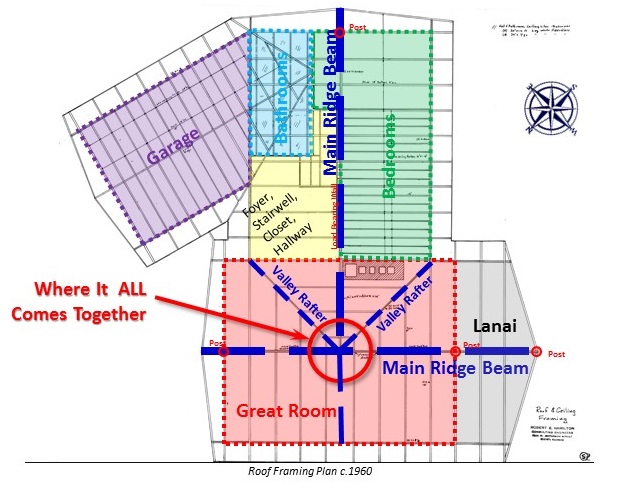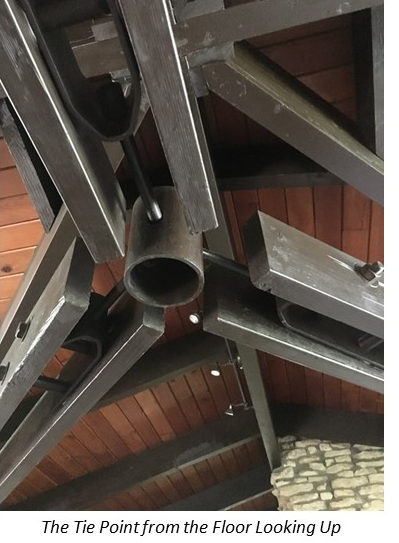


An Engineer in the Woods, Installment 3: The Roof
Thursday, August 3, 2017
Our home is unique for many reasons. The setting, the family that built the home and has lived there for the past 53½ years, the way that it was built and remodeled, the critters that have infested it.., are all important to this home’s story. However, the true heart-stopper of our home is the architecture, and even that has several different tales that I can write about as this home surprises and delights you (frustrates me!) in every corner. But of all the architectural details, it’s the exposed beams, vaulted ceilings, clear-story windows, and the size of the Great Room that get the first and biggest “oohs and aahs.”
The gray-weathered board and batten Hemlock sided California Ranch home is an example of Craftsman Style Post and Beam Construction, with one significant component missing. The posts. The main posts are hidden as stiles in the clear-story windows in the Master Bedroom and at both ends of the Great Room and Lanai (a fancy word for screened-in back porch that I learned in Florida). But the post that’s missing is where the two main Ridge Beams of the house come together at the center of the Great Room. I put together a sketch from Dad’s original hand-drafted plans to help you understand how this works (he put the North arrow down-left, not me! 😊):

I learned some of the stories about the construction as a kid, but I never appreciated the brilliance of the design until I lived in the house as an adult engineer.
A few things first:
- I am not a structural engineer although, like all civil engineers, I took structural classes in college- but I didn’t like them, and they didn’t like me either!
- I’m not an architect, so some of the terms that I use might make some of my architect friends cringe.
- I am not writing this for architects and engineers. I’m trying to tell a story; hence I’m giving just a little bit of technical background so that I can refer to some of the details in this and future blogs.
Most homes have truss roofs with flat ceilings and an attic. As the weight of the roof pushes down on the top chord of the truss, that force tries to spread the walls apart. The bottom chord of the truss is put into tension by this downward force and that keeps the walls from pushing out. This combination of forces is what holds the roof up. Most vaulted ceilings have a modified truss where there is still air space between the ceiling and the roof, and the structural principles are the same.
A Post and Beam roof uses a large beam at the top of the roof (Ridge Beam) supported by Posts. The Rafters hang off this Ridge Beam and are supported by both that beam and posts within the walls.

In our Post & Beam home, when you look up, instead of a flat drywall ceiling, you’re seeing 3,000 sf of golden #1 fir 2x8 tongue & groove roofing planks. There is tar paper, closed-cell insulation, plywood, water barrier and shingles above that, but you’re essentially seeing the bottom of the roof. All of the dark brown 4x16 beams and 4x10 rafters on 48” centers that support that roof are visible throughout the main floor of the home.

Kristen and I made A LOT of changes when we remodeled the home in 2015, but the main floor ceilings, with three exceptions, are identical to the day they were constructed in 1963. The three changes we made were to take out the drop ceilings in the Center Hallway, Hall Bathroom and Master Bathroom so that we could see even more of the beams, rafters and ceilings! We also added a clear story interior window above the Master Bedroom door so that when you stand near the center of the Great Room you can look in three directions along either of the Main Ridge Beams, through the exterior clear story windows and see the tree tops on three different sides of the house from one location (with occasional lurking critters looking back).
Dad originally had designed a post to support the intersection of the two main Ridge Beams and the Valley Rafters. The rafter that now extends from the Bedroom Main Ridge Beam is not shown on the original plans, but the plans show a 4x4 post as the corner of a wet bar and bookshelves at the corner of the former kitchen (I’ll tell you about floorplan revisions in a future blog, this one is about the roof). I’m not sure why the support system was revised, but I suspect that an Uncle was consulted (see Appendix). I know that Dad often asked Uncle Hal about the roof because my father was always a little concerned about his design. 53½ years, two tornadoes and 3- 30”+ snowstorms should be confirmation of the design, but I’ve inherited the superstition to always “knock wood” when I talk about the roof.
When the house was under construction, Dad added three tension chords (double 3x8 timbers with a clevis and bolts, each bolted into a 4” diameter steel pipe Tie Point) to tie the Valley Rafters into the intersection of the Main Ridge Beams. But he kept his original support post in place
As Dad used to tell it,

“Even though it wasn’t necessary to support the roof, I left the post in the design because the carpenter needed it to frame the house.
One morning I looked and decided that the room would be much more open without the post and, sadly, the bar. So,I asked the carpenter
if he could take the post out."
‘Ain’t no way to do it.’
‘Why not?’
‘Too much pressure on it,’ the carpenter said tapping on the post with a hammer and showing that it was not moving.
‘You need to tighten the bolts then.’
‘That won’t change nothin’, and I still ain’t takin’ that post out!
Unless you’ve got the guts to be standin’ next to me when I try to do it??’
‘All right, I will.’”
Dad stood next to the carpenter, and he went on to tell,
“The carpenter went around in a circle and sequentially tightened the nut on each of the three bolts at the back of the clevises a ¼ turn. About the third or fourth time around I noticed that the roof appeared to be getting higher and the post was hanging off the ground. I started to say something just as the post dropped and toppled, hitting the carpenter on the head. ‘Still think you need that?’ Son, it never pays to be a smart-ass.”
Wish I’d learned that lesson sooner.
____________________________________________________________________________________________________________
An Engineer in the Woods, Installment 3: Appendix, My Family of Engineers
My Grandpa James Hamilton was born during the Civil War and passed away at the age of 91, 6 years before I was born. He had caught pneumonia on a duck hunting trip. For much of his working life he was a successful partner in Hamilton Brothers Construction in Texas where, toward the end of the 19th century and over the first ¼ of the 20th century, he designed and built sewer and water systems for towns throughout the southwest, but mainly in Texas. Around 1910 he met a Joliet girl there, Vida Krans, and they were married. Several years later, when they moved their family to Joliet, allowing Grandma to be close to her family, he himself built their expansive house on Cowles Avenue. My father caught the construction bug from him and after serving in WWII Dad earned his Master’s degree in Civil-Sanitary Engineering from the University of Illinois. Dad’s older brother Jim was also impacted by Grandpa Ham’s passion for construction because he had graduated from the University of Illinois before the war, married my Aunt Millie, and became a civil engineer for the Louisville District of the Army Corps of Engineers. His sister, Helen, married a Chemical Engineer (Uncle Jack) and moved with him to Connecticut.
My mother’s youngest sibling, Bill, went to the University of Illinois after recovering from his war injuries, became a Civil Engineer and moved to New York with his wife (Aunt Priscilla) where he formed a company that sold water and wastewater treatment equipment. Mom’s younger sister, Janet, married a Civil Engineering student at the University of Illinois (Uncle Hal, also a veteran) who graduated “Bronze Tablet” (top of his class), and became a top bridge engineer for an international Structural Engineering firm in St. Louis.
Only Uncle Hal and Aunt Pris remain from that generation – and ALL of them, and my cousins, would regularly come to Joliet to help to build our house! You can imagine what family get-togethers were like, especially when they revolved around building a house. My earliest memories are about my engineer uncles talking about engineering while they hammered and wired and landscaped and painted and shingled and plumbed (and drank beer). I think the beer tabs that I found in some of the walls during our remodel explain why it appears that they occasionally forgot to use a level!
“Howard, why did you become an engineer?”
“I dunno. What else is there?”
My brother Bruce was a University of Illinois Civil Engineer and his wife Marsha has a mathematics degree from the University of Illinois. My younger sister Helen (also a U of I grad) is married to a University of Illinois Electrical Engineer, and my wife Kristen is a University of Illinois Electrical Engineer. My older sister Jan is our favorite because her family is U of I and engineer-free. She was a teacher and has retired to Lake Geneva where she works in a greenhouse and her husband Bob owns and operates Maple Park Antiques *
So, here’s the engineer count:
1 Grandfather
1 Father
4 Uncles
1 Brother
1 Brother In-Law
1 Wife
1 Me
10 7 Civil, 2 Electrical and 1 Chemical and all but Grandpa Ham and Uncle Jack went to the University of Illinois
Ummm, I guess I have engineering (and the Chief!) in my blood..?
*Hey Bob, notice the hyperlink?? Is that good for any special family sale pricing for the best antiques at the best store EVER?
note: we have a lot of great antiques in our home. Some are hand-me-downs, but many of them have come from Bob. He finds some great stuff at GREAT prices and his downtown store in Lake Geneva, Wisconsin is worth the trip.
Bob’s almost always in a good mood. Mention my name and watch it change :( .

Have a beautiful day!
Howard